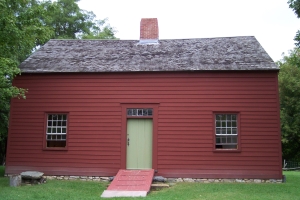 Scene at Godard College
interested in hearing from friends with more recent knowledge of Godard.
Scene at Godard College
interested in hearing from friends with more recent knowledge of Godard.
New England is a curious combination of uninhabited forest and hills and water, punctuated with villages and cities. We began our Autumn exploration in Burlington, Vermont, enjoying the beauty of the forest and waters in late summer, as the trees are just beginning to change color.
Driving to Burlington, we stopped briefly at Godard College, which we remember from our college days as a rather exotic small school where education concentrated on the arts. Today, half a century later, it's still in business, though still small and rather shabby, at least to outward appearances. We'd be  Scene at Godard College
interested in hearing from friends with more recent knowledge of Godard.
Scene at Godard College
interested in hearing from friends with more recent knowledge of Godard.
Shabbiness, in fact, seems to be rather pervasive in the Northeast. Vermont's capital, Montpelier, has more than its share of boarded-up businesses. In the countryside we passed many houses needing fairly major repairs and repainting (we have become accustomed to the Newfoundland custom of repainting and roof repair which seems to be a continual process there).
However, Ben and Jerry's Ice Cream is alive and well. We enjoyed our tour at their home plant which concluded with two samples of ice cream.
And throughout New England we do enjoy seeing the particular New England architecture which so far has included two round buildings. The first, a church, was said to have been built round to prevent the devil from hiding in the corners. The second, a barn, is the visitor center for a Must-See museum in Shelburne, Vermont, near Burlington.
We almost didn't visit this museum. On our first try, we got to the gate only to discover that it was the annual Dog Picnic. Indeed, we passed several  Shelburn Museum kitchen
dogs eagerly leading their masters to the gate. But we gave it a second try and we're happy we did. The Shelburne Museum was developed by Electra Havemeyer Webb, a devoted collector of folk art, antiques and early American buildings, who amassed her collection mostly during the 1930s and 1940s. Now the museum occupies most of the grounds of her original estate, with examplar buildings -- schoolhouse, church, farmhouse, barn etc. -- dotted about, with just enough distance for a good walk, along paths which reminded us of the original Greenfield Village in Michigan before it became too large and commercial.
Shelburn Museum kitchen
dogs eagerly leading their masters to the gate. But we gave it a second try and we're happy we did. The Shelburne Museum was developed by Electra Havemeyer Webb, a devoted collector of folk art, antiques and early American buildings, who amassed her collection mostly during the 1930s and 1940s. Now the museum occupies most of the grounds of her original estate, with examplar buildings -- schoolhouse, church, farmhouse, barn etc. -- dotted about, with just enough distance for a good walk, along paths which reminded us of the original Greenfield Village in Michigan before it became too large and commercial.
In the Shelburn Museum, many of the buildings are galleries for collections on specific themes: toys, weathervanes, American pressed glass, paintings. This year, one gallery is devoted to the work of children's illustrator Barbara Cooney, a New Englander who has incorporated Maine and New Hampshire settings into many of her books. In a small nearby gallery devoted to Quebecois furniture we watched a charming French-Canadian film, "Crac", which stars a rocking chair. Later, in a gallery devoted to music boxes and automatons, a video described how each of the models on display had been designed, and what the clockwork interior  Shelburn Museum sleigh
looked like. After a morning's ramble, we still hadn't seen much of the collections and plan to return the next time we are near Burlington.
Shelburn Museum sleigh
looked like. After a morning's ramble, we still hadn't seen much of the collections and plan to return the next time we are near Burlington.
Our second museum visit took us to the home of Ethan Allen, on the outskirts of Burlington. This home has been restored by local historians and archaeologists and is now part of a local park, which assures that the surroundings resemble the wilderness of three hundred years ago. The guided tour concentrates on the typical life of an eighteenth-century pioneer: Ethan and his family moved into this house toward the end of his life, years after the American Revolution, when the Green Mountain Boys were no longer active.
We quickly discovered that all we remember of this man is that he was the leader of the Green Mountain Boys, a kind of guerilla outfit. Reading a fascinating biography (originally published 40 years ago), by Stewart Holbrook, we learned that the Green Mountain Boys fought the efforts of New York and New Hampshire and Canada to annex Vermont. Without Ethan Allen, there would be no Vermont today. This large, rambuctious, wild man was also an important player in the early days of the Revolution, and survived imprisonment of over a year in dreadful conditions on a British prison ship.
Perhaps the most astonishing aspect of his character, though was his religious philosophy. He had nothing to do with churches or ministers or any aspect  Ethan Allen's Home
of the prevailing Christianity. One of the last major projects of his lift was writing a long book explaining his ideas of religion. As can well be imagined, this was extremely controversial, and nobody was very surprised when a mysterious fire at the printing plant destroyed all but about five of the 1500 copies that he had ordered. A largely self-educated man, a drinker and brawler, he was nevertheless a completely sincere patriot and always honest in his dealings with others. He was one of the larger-than-life men who helped shape the character of the young United States, and deserves to be much better known.
Ethan Allen's Home
of the prevailing Christianity. One of the last major projects of his lift was writing a long book explaining his ideas of religion. As can well be imagined, this was extremely controversial, and nobody was very surprised when a mysterious fire at the printing plant destroyed all but about five of the 1500 copies that he had ordered. A largely self-educated man, a drinker and brawler, he was nevertheless a completely sincere patriot and always honest in his dealings with others. He was one of the larger-than-life men who helped shape the character of the young United States, and deserves to be much better known.
We're in New Hampshire now, enjoying a routine of slowly catching up with all of the threads we had dropped over the summer. We have filled our *living room* at the Residence Inn with our three folding tables and three of our laptops and stacks of books. Thanks to local custom, we have a library card at the local library and have already borrowed our first books.
When we think about our summer in Canada we remember the land and the clear air and the vast empty spaces, the friendly and self-sufficient people, the colors of the houses in Newfoundland and the little fishing boats in the outports, drawn up against the shore. We remember the taste of partridgeberry and bakeapple jam, the sight of the oil-rig supply boats sliding quietly in and out of the harbor at St. John's. Atlantic Canada continues to be, in our opinion, one of the magic places of North America, and we look forward to returning again, sometime.